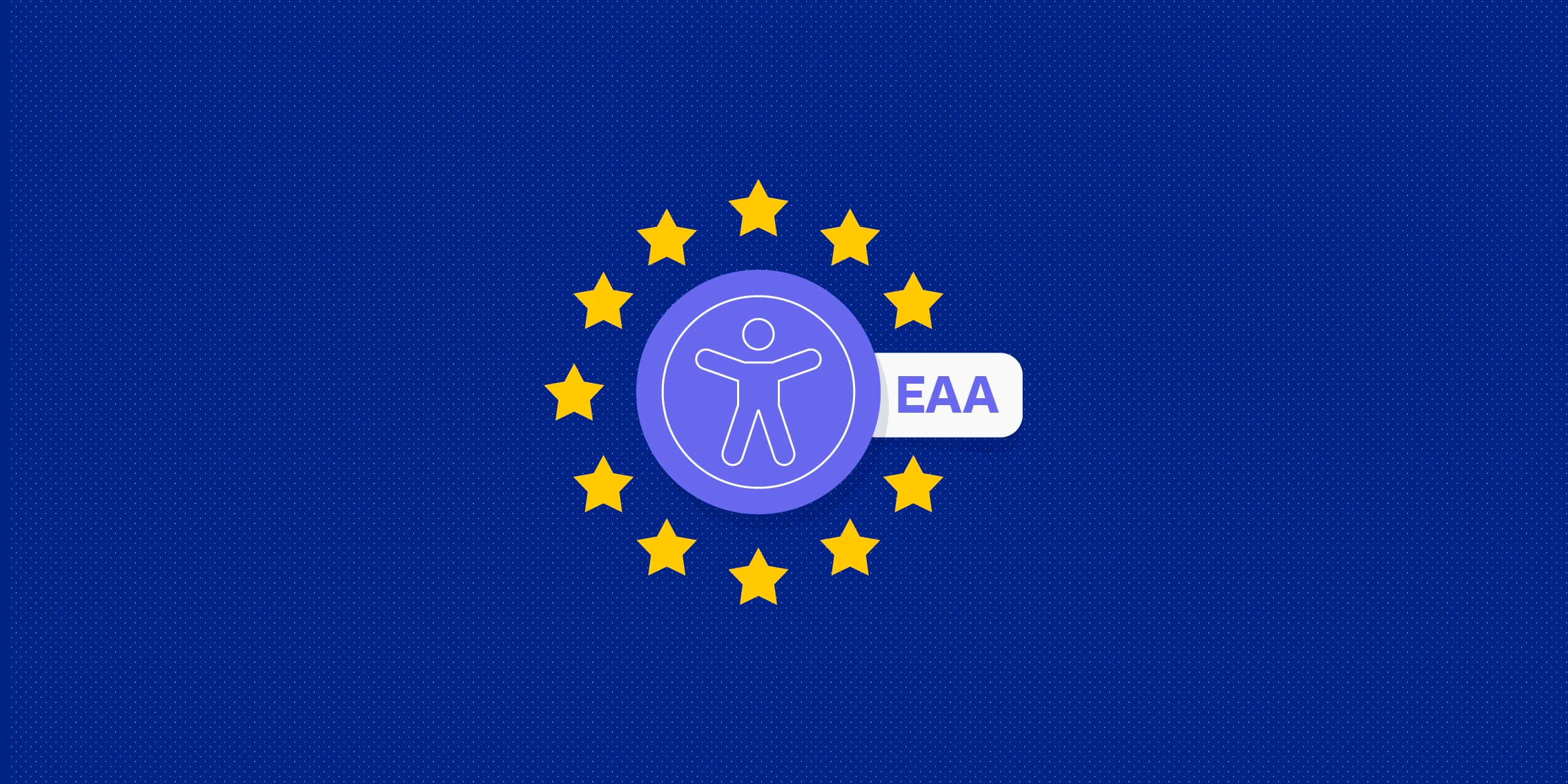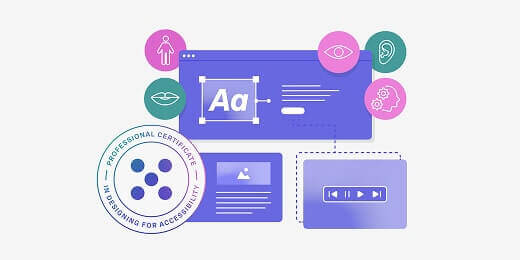If you’ve heard of the European Accessibility Act (EAA) and the June 28, 2025, compliance deadline, you may be wondering: What does it mean for me as a designer and for the UX industry as a whole?
Whether you’re preparing for compliance or simply want to make sure you’re keeping up with best practices and consumer expectations, it’s time to make accessible design a priority.
In this guide, we explain everything you need to know about the European Accessibility Act. We’ll also share practical steps to help you prioritise accessibility within your own design practice and ultimately create better products and experiences for everyone.
What is the European Accessibility Act?
The European Accessibility Act (EAA) is a law created by the European Union to ensure that crucial products and services are easier for people with disabilities to use.
It means that things like websites, smartphones, ATMs, ticket machines, e-books, and public transport apps must be designed in a way that’s accessible to everyone, including people with vision, hearing, or mobility issues.
The main goal of the Act is to create more inclusive products and services across Europe, with all EU member states being held to the same guidelines and standards.
But the European Accessibility Act has actually been around since 2019, so why the sudden interest now?
Although the Act has been in effect for years, 2025 marks an important compliance deadline. As of 28th June 2025, any new products or services launched within the European Union must fully comply with the EAA.
Products and services that already exist have another five years — until 28th June 2030 — to meet accessibility standards. Beyond that, failure to comply may result in severe penalties.
So, who exactly needs to take note of the EAA and prepare for compliance? Let’s take a look.
Who needs to comply with the EAA?
The European Accessibility Act applies to a whole host of product and service types, including:
- Computers and operating systems
- ATMs, ticketing, and check-in machines
- Smartphones
- TV equipment related to digital television services
- Telephony services and related equipment
- Access to audiovisual media services such as TV broadcast and related consumer equipment
- Services related to air, bus, rail, and waterborne passenger transport
- Banking services
- E-books
- E-commerce
So, if you’re a business or designer operating within one of those categories, and you’re based in the EU and/or have customers in the EU, you need to be compliant with the Act.
However, micro-enterprises, which are defined as businesses with fewer than 10 employees and an annual turnover or balance sheet total below €2 million, may be exempt from certain requirements depending on national implementation.
But even if you’re not required to comply from a legal standpoint, if you’re designing user-facing products and experiences, you should be striving to meet accessibility standards.
Why? Because accessible design is ultimately good design. It’s inclusive, it’s user-friendly, and it ensures your products can be enjoyed by everybody.
It’s also a case of meeting your users’ expectations and staying competitive. If you’re not prioritising accessibility, you risk losing valuable customers who can easily take their business elsewhere.
So, whether or not you’re legally impacted by the EAA, we strongly recommend using it as a guideline to improve your products and services.
With that, let’s take a closer look at the exact requirements set out by the Act.
The main accessibility requirements set out by the EAA
The ultimate goal of the EAA is to remove accessibility barriers from everyday products and services (both physical and digital), ensuring that everyone can use them.
Specifically, the EAA stipulates that products and services must be:
- Perceivable: Users must be able to perceive content and interfaces, regardless of their sensory abilities. So, for example, a user with low vision must have a suitable option for perceiving information, say, in audio format or using an assistive device.
- Operable: Users must have multiple options for how they can interact with and navigate an interface, such as keyboard input, voice commands, and assistive technology.
- Understandable: Any information and interfaces that the user encounters must be clear, predictable, and comprehensible.
- Robust: Products and services must work with a wide range of assistive technologies, and they must be robust enough that they can evolve to accommodate future assistive technologies as they develop
To meet these requirements, products must comply with both the harmonised European standard for IT accessibility, known as EN 301 549, and with Web Content Accessibility Guidelines (WCAG) 2.1.
What are EN 301 549 and WCAG?
EN 301 549 is a technical framework used across the EU to measure whether digital products and services are accessible. As a UX designer, you don’t need to be familiar with every line of it, but you do need to understand its role in accessible and inclusive design.
Ultimately, EN 301 549 brings various accessibility standards together, including (most importantly for designers) the Web Content Accessibility Guidelines (WCAG) 2.1. These guidelines focus on the four key principles of accessibility (which we outlined previously), making sure that digital content is perceivable, operable, understandable, and robust.
To comply with the European Accessibility Act, you’ll need to meet WCAG 2.1 guidelines at the AA level. This includes things like:
- Making sure there’s sufficient contrast between text and background
- Ensuring all interactive elements can be accessed using a keyboard
- Providing clear focus states (i.e. visual indicators that show which element on the page is currently selected) and consistent navigation
- Writing clear, concise instructions and avoiding jargon (these fundamental content design principles will help you)
- Making sure screen readers can interpret the content correctly
So, in short: while EN 301 549 is the umbrella standard used to measure compliance with the European Accessibility Act, you’ll mostly use WCAG 2.1 to guide your design decisions. You can learn more about the Web Content Accessibility Guidelines and their importance here.
With that, let’s take a closer look at what the EAA means for UX design in practical terms.
What does the European Accessibility Act mean for UX design?
With the European Accessibility Act (EAA), accessibility can no longer be considered an add-on or a ‘nice-to-have’. It’s now a legal imperative for many products and services, which means that it must become an integral part of the design process.
So what does this mean in practice?
First and foremost, it calls for a shift in mindset. Accessibility can’t just be something you patch on at the end; it has to be considered at every stage of your workflow — from user research, ideation, and wireframing, right through to prototyping and testing.
That might mean asking more inclusive questions when conducting user interviews, testing early design ideas with people who use assistive technology, and using accessibility checklists and colour contrast tools as a standard part of your toolkit.
Speaking of tools, you’ll also need to ensure that you’ve got the right programs and processes in place to support accessible design. Any design systems you use should include accessible components by default, such as buttons with proper contrast and focus states, forms with clear labels, and keyboard-friendly navigation systems.
If you’re using Figma (or similar tools), you can start to build accessibility details directly into your design files. For example, you might add notes to individual components explaining how they should work with screen readers, or what alt text should be used.
Designing for accessibility also calls for even tighter collaboration among designers and developers. Both teams must ensure that accessibility features are implemented as intended, and accessibility testing must become a regular part of QA testing (not just a one-off audit before launch).
Ultimately, accessibility should factor into and influence every design decision. Designers will need to be asking the right questions at every step — like is this text large and clear enough to read? Or can this form be completed using only a keyboard? How does this interface feel and function for someone using a screen reader?
If you’re already prioritising accessibility within your design practice, the EAA won’t feel like a massive change. But if you’re now only just starting to think about accessible design, it’ll take time to adjust your mindset and your practical approach.
However, the long-term implications of the Act are overwhelmingly positive. Ultimately, we all want good design to prevail — and when you design for accessibility, you’re creating more inclusive, equitable, and enjoyable digital experiences for everyone.
Challenges and opportunities for UX teams
The key to accessible design is making it a core part of your UX process — but that’s often easier said than done. In practice, things like limited knowledge, time constraints, and unclear ownership can all get in the way.
All too often, accessibility is seen as a checkbox or an afterthought, especially if you’re grappling with tight deadlines, smaller budgets, and client or stakeholder expectations that don’t align with accessibility requirements.
And even if you’ve got the time and resources available — and the best of intentions — accessibility can fall by the wayside if designers don’t feel they have the necessary knowledge and skills, or if there’s no one clearly advocating and taking responsibility.
But the European Accessibility Act is set to change that. Whether or not you’re legally obliged to comply, this is a great opportunity to design better, more inclusive products that can reach more people and set you apart from competitors.
So, how can we reframe those all-too-common obstacles to accessible design and turn them into opportunities instead?
First and foremost, treat accessibility as a team effort, not something that’s left to individual designers or developers. Ideally, everyone who touches the product will be thinking about accessibility. But to get to that point, you’ll probably need someone (or a few people) to lead the charge.
If you’re leading a design team, take it upon yourself to advocate for accessible design, or designate one or two trusted team members. Then, work together to create resources and guidelines that everybody can refer to — like an accessible UI checklist, for example, or a guide to inclusive language.
At the same time, encourage team-wide learning, knowledge sharing, and skill development. You might organise workshops, create a Slack channel to share helpful resources, or sign up for formal training.
And perhaps most importantly, shift the way that accessibility is framed. It’s not just a box to tick; it’s an integral part of the (good) design process, and it should be positioned as such.
Note that you don’t need to be leading a UX team to become a more accessible and inclusive designer. Whether you’re working solo, heading up a huge department, or reporting in as a junior designer, anybody can (and should) learn more about accessible design and find ways to prioritise it.
How to prepare for the EAA (and remain compliant)
If you’re a UX designer working in the EU or designing products that are used by people in the EU, you need to make sure you’re compliant with the EAA. And even if the Act doesn’t apply to you legally, this is a great opportunity to design better, more accessible experiences.
Here are some first steps you can take to start aligning your work with the EAA — and get set up for long-term compliance.
1. Get familiar with WCAG 2.1
As we mentioned earlier, the European Accessibility Act uses EN 301 549 as its benchmark, which draws heavily from the Web Content Accessibility Guidelines (WCAG) 2.1.
These guidelines set the standard for accessible digital content, so it’s essential that you understand them (especially the Level AA requirements, as that’s what you’ll need to fulfil). You’ll find all official documentation on the W3C website.
2. Conduct an accessibility audit
Audit your existing product(s) to see how they currently fare in terms of accessibility — and to highlight any major issues that need addressing as a priority.
You can use automated tools for a first check (like this WCAG compliance checker by AudioEye), but it’s also worth conducting more in-depth manual checks and, eventually, getting real user feedback.
This should give you an idea of where to focus your efforts in the lead-up to the compliance deadline. Then, you’ll need a more long-term strategy to continuously audit your products and remain compliant.
Read also: How to optimise your website for accessibility (7 practical tips).
3. Integrate accessibility tools into your workflow
Next, think about upgrading your design toolkit to prioritise and improve accessibility.
Consider plugins like Stark, Able, and Contrast — these can be integrated directly with Figma or Sketch to highlight problems such as low colour contrast, missing alt text, or inaccessible font choices. Some even let you simulate different types of visual impairments, helping you understand how your designs might be experienced by a wider range of users.
Do your research and experiment with different options to see which tools work best with your existing stack.
If accessibility is going to become part of your team’s culture, it needs to be part of your shared resources. And the sooner you start creating these shared resources, the sooner you’ll have everyone on board.
Start with your design system, ensuring that accessible design patterns, components, and UI elements are readily available. Create reusable templates for things like buttons, forms, and navigation that meet accessibility guidelines — and document best practices for accessible design.
And most importantly, make sure these resources are easy to find, whether through shared drive folders or internal wikis. The goal is to set a universal standard across the product, ensuring consistency in your team’s approach to accessible design.
5. Consider formal training
Accessible design is both a mindset and a skill set, and formal training can set your team up for success. Consider an official course like the UX Design Institute’s Professional Certificate in Designing for Accessibility, which has been created to help design teams comply with accessibility standards and generally improve their design practices.
You’ll learn not only how to design accessible digital products, but also how to advocate for accessibility and get stakeholder buy-in — a crucial yet often tricky step.
Whether for yourself or your team, formal training can also help to cement the idea that accessibility is an integral part of the design process, not a nice add-on, but a fundamental prerequisite for achieving good UX.
The takeaway
The European Accessibility Act (EAA) strives to create more accessible and inclusive digital experiences across the board, and it applies not only to companies operating within the European Economic Area, but also to any organisation whose customers are in the EU.
Ultimately, the Act is built on WCAG 2.1, so that’s your essential starting point for compliance. Beyond that, seek to create an accessibility-first approach within your design culture through education and skill-building, shared resources, day-to-day design practices, and ongoing advocacy.
Whether you’re prioritising accessibility for EAA compliance or simply want to level up your design practice, the outcome is the same: better products and experiences for everyone. And that’s something we can all celebrate!
Want more practical tips and insights? You can learn more about accessible design in the following guides:
- What is accessible design, and why does it matter?
- Accessible vs. inclusive vs. universal design — what’s the difference?






